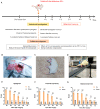The Effects of Unilateral Labyrinthectomy on Monoamine Neurotransmitters in the Medial Vestibular Nucleus of Rats
- PMID: 38002319
- PMCID: PMC10669524
- DOI: 10.3390/biom13111637
The Effects of Unilateral Labyrinthectomy on Monoamine Neurotransmitters in the Medial Vestibular Nucleus of Rats
Abstract
Background: This study aimed to investigate the effects of unilateral labyrinthectomy (UL) on monoamine neurotransmitters in the medial vestibular nucleus (MVN) of rats.
Methods: Adult Sprague-Dawley rats were utilized for the vestibular impaired animal model through UL. The success of the model establishment and the recovery process were evaluated using vestibular behavioral tests, including spontaneous nystagmus, postural asymmetry, and balance beam test. Additionally, the expression levels of c-Fos protein in the MVN were assessed by immunofluorescence. Furthermore, changes in the expression levels of monoamine neurotransmitters, including 5-hydroxytryptamine (5-HT), norepinephrine (NE), dopamine (DA), and histamine in the MVN, were analyzed using high-performance liquid chromatography (HPLC) at different time points after UL (4 h, 8 h, 1 day, 2 days, 4 days, and 7 days).
Results: Compared to the sham control group, the UL group exhibited the most pronounced vestibular impairment symptoms at 4 h post-UL, which significantly decreased at 4 days and almost fully recovered by 7 days. Immunofluorescence results showed a notable upregulation of c-Fos expression in the MVN subsequent to the UL-4 h, serving as a reliable indicator of heightened neuronal activity. In comparison with the sham group, HPLC analysis showed that the levels of 5-HT and NE in the ipsilesional MVN of the UL group were significantly elevated within 4 days after UL, and peaked on 1 day and 2 days, respectively. DA showed an increasing trend at different time points up to 7 days post-UL, while histamine levels significantly increased only at 1 day post-UL.
Conclusions: UL-induced dynamic changes in monoamine neurotransmitters during the early compensation period in the rat MVN may be associated with the regulation of the central vestibular compensation mechanism by the MVN.
Keywords: high-performance liquid chromatography; medial vestibular nucleus; monoamine neurotransmitters; unilateral labyrinthectomy; vestibular compensation.
Conflict of interest statement
The authors declare no conflict of interest.
Figures



Similar articles
-
Changes in Histamine Receptors (H1, H2, and H3) Expression in Rat Medial Vestibular Nucleus and Flocculus after Unilateral Labyrinthectomy: Histamine Receptors in Vestibular Compensation.PLoS One. 2013 Jun 19;8(6):e66684. doi: 10.1371/journal.pone.0066684. Print 2013. PLoS One. 2013. PMID: 23840519 Free PMC article.
-
[Changes in sensitivity of bilateral medial vestibular nuclear neurons responding to input stimuli during vestibular compensation and the underlying ionic mechanism].Sheng Li Xue Bao. 2022 Apr 25;74(2):135-144. Sheng Li Xue Bao. 2022. PMID: 35503061 Chinese.
-
[Influence of betahistine on the expression of histamine H3 receptor in the medial vestibular nucleus following unilateral labyrinthectomy in guinea pigs].Zhonghua Er Bi Yan Hou Tou Jing Wai Ke Za Zhi. 2014 Dec;49(12):1027-30. Zhonghua Er Bi Yan Hou Tou Jing Wai Ke Za Zhi. 2014. PMID: 25623873 Chinese.
-
Rapid compensatory changes in GABA receptor efficacy in rat vestibular neurones after unilateral labyrinthectomy.J Physiol. 2000 Mar 1;523 Pt 2(Pt 2):413-24. doi: 10.1111/j.1469-7793.2000.t01-1-00413.x. J Physiol. 2000. PMID: 10699085 Free PMC article.
-
Vestibular compensation: Neural mechanisms and clinical implications for the treatment of vertigo.Auris Nasus Larynx. 2024 Apr;51(2):328-336. doi: 10.1016/j.anl.2023.11.009. Epub 2023 Dec 19. Auris Nasus Larynx. 2024. PMID: 38114342 Review.
Cited by
-
Molecular profile of vestibular compensation in the medial vestibular nucleus after unilateral labyrinthectomy.J Cell Mol Med. 2024 Jul;28(14):e18532. doi: 10.1111/jcmm.18532. J Cell Mol Med. 2024. PMID: 39039705 Free PMC article.
-
Advanced progress of vestibular compensation in vestibular neural networks.CNS Neurosci Ther. 2024 Sep;30(9):e70037. doi: 10.1111/cns.70037. CNS Neurosci Ther. 2024. PMID: 39268632 Free PMC article. Review.
-
Study on the Central Neural Pathways Connecting the Brain and Peripheral Acupoints Using Neural Tracers.CNS Neurosci Ther. 2025 Aug;31(8):e70554. doi: 10.1111/cns.70554. CNS Neurosci Ther. 2025. PMID: 40762123 Free PMC article.
References
-
- Fetter M. Acute unilateral loss of vestibular function. Handb. Clin. Neurol. 2016;137:219–229. - PubMed
Publication types
MeSH terms
Substances
Grants and funding
LinkOut - more resources
Full Text Sources

